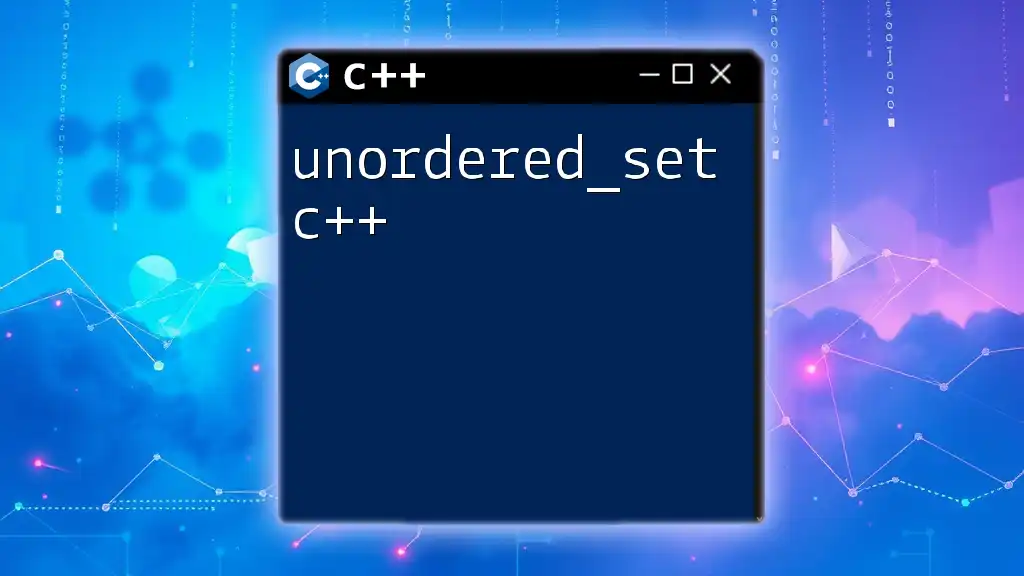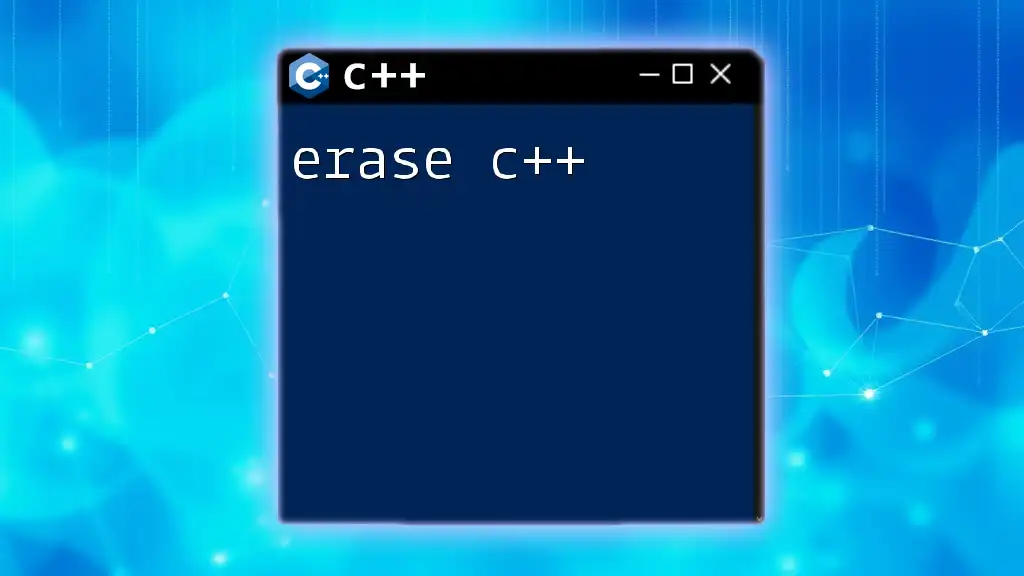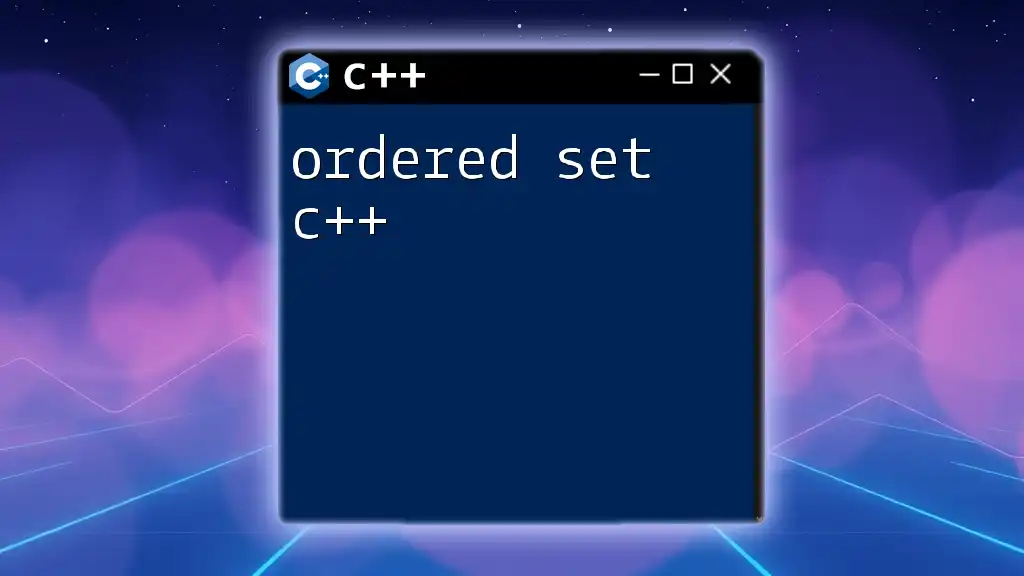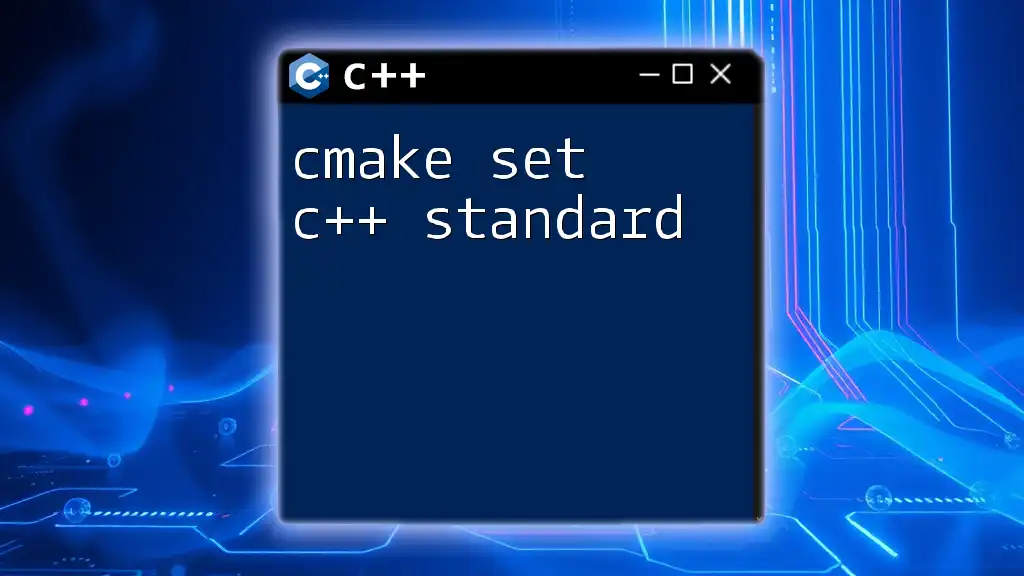An ordered set in C++ can be implemented using the `std::set` container from the Standard Library, which stores unique elements in a specific order based on their value.
Here's a simple code snippet demonstrating the usage of `std::set`:
#include <iostream>
#include <set>
int main() {
std::set<int> orderedSet {5, 1, 3, 4, 2}; // Elements will be stored in ascending order
// Display the elements of the ordered set
for (const int &element : orderedSet) {
std::cout << element << " ";
}
return 0;
}
What is an Ordered Set?
An ordered set in C++ is a data structure that maintains a unique collection of elements in a specific order. Unlike traditional sets, which offer no guarantees regarding the order of their elements, ordered sets ensure that the elements are stored in a sequence defined by a comparison function or in their natural ascending order. This unique ordering makes ordered sets particularly useful in scenarios where the order of elements is vital for processing or presentation.
Maintaining order in a data structure allows for tasks such as finding the smallest or largest element efficiently. Furthermore, ordered sets enable operations that rely on sorting, such as merges and intersections, to be performed with ease.

Why Use Ordered Sets?
Using ordered sets offers numerous advantages over conventional sets. Here are a few reasons why you might want to implement them in your C++ projects:
- Automatic Ordering: Elements are automatically sorted, which removes the need for manual sorting after insertion.
- Fast Lookups: Ordered sets provide efficient search operations, making it easy to find elements quickly.
- Easy Range Queries: They allow you to easily access a range of values, thanks to their ordered nature.
The combination of these features makes ordered sets suitable for a variety of applications, from managing lists of items in games to scheduling tasks or maintaining a leaderboard.

Understanding the Basics
What is a Set in C++?
A set in C++ is a collection that holds unique elements, which means no duplicates are allowed. The standard library provides the `std::set`, which is an implementation of a balanced binary tree and maintains the order of elements automatically. It ensures that elements are stored in a way that allows for efficient searching, insertion, and deletion.
The Concept of Order
In an ordered set, the order is maintained based on a comparator, which can be either a predefined comparison operator (like `<`) or a custom comparator defined by the programmer. This ordering is typically implemented internally using a red-black tree or AVL tree, allowing for logarithmic time complexity for core operations.

Implementing Ordered Sets in C++
Including the Required Header
To use ordered sets in your C++ program, you need to include the `<set>` header file, which contains the necessary definitions:
#include <set>
Basic Operations
Inserting Elements
To insert elements into an ordered set, use the `insert` method as shown below. The set automatically organizes the elements in ascending order:
std::set<int> orderedSet;
orderedSet.insert(5);
orderedSet.insert(1);
orderedSet.insert(3);
After the above insertions, `orderedSet` will contain the elements in the order `{1, 3, 5}`, regardless of the order in which they were inserted.
Accessing Elements
You can iterate through the elements of an ordered set with the help of iterators. An example is provided below, showcasing how to access and display the elements in order:
for(auto it = orderedSet.begin(); it != orderedSet.end(); ++it) {
std::cout << *it << " ";
}
The output will display the elements in ascending order, reflecting the inherent ordering of the set.
Erasing Elements
Removing elements from an ordered set is straightforward using the `erase` method. Upon erasure, the set will still maintain its order:
orderedSet.erase(1);
After this operation, `orderedSet` will contain `{3, 5}`.

Advanced Features
Finding Elements
Finding elements in an ordered set is efficient due to the underlying data structure. You can use the `find` method as shown below:
auto search = orderedSet.find(3);
if (search != orderedSet.end()) {
std::cout << "Found: " << *search << std::endl;
}
This facilitates O(log n) search times, making ordered sets highly efficient for lookup operations.
Set Operations
Union
You can perform set operations like union with ordered sets. The example below demonstrates how to create a union of two ordered sets:
std::set<int> set1 = {1, 2, 3};
std::set<int> set2 = {3, 4, 5};
std::set<int> unionSet;
std::set_union(set1.begin(), set1.end(), set2.begin(), set2.end(),
std::inserter(unionSet, unionSet.begin()));
After executing the above code, `unionSet` will contain `{1, 2, 3, 4, 5}`.
Intersection
Intersection works similarly and can be performed as follows:
std::set<int> intersectionSet;
std::set_intersection(set1.begin(), set1.end(), set2.begin(), set2.end(),
std::inserter(intersectionSet, intersectionSet.begin()));
The resulting `intersectionSet` will contain `{3}`, demonstrating how ordered sets can enable efficient grouping operations.
Custom Comparators
C++ allows you to use custom comparison functions for your ordered set, enabling you to define your own ordering rules. For instance, if you wish to sort in descending order:
struct Compare {
bool operator() (int a, int b) const {
return a > b; // Descending order
}
};
std::set<int, Compare> customSet;
This custom comparator offers flexibility, catering to specific application needs, such as reverse sorting.

Performance Considerations
Time Complexity
Ordered sets provide efficient performance with logarithmic time complexity (O(log n)) for insertion, deletion, and lookup operations. This efficiency stems from the balanced tree structure used internally.
Memory Considerations
It’s essential to note that while ordered sets maintain ordering and uniqueness, they may consume more memory than a simple vector or array, particularly due to the overhead associated with maintaining the tree structure. However, the benefits of optimized search and insertion generally outweigh these concerns in the majority of applications.

Practical Applications
Use Cases
Ordered sets find applications in various real-world scenarios. They are particularly useful for:
- Managing Unique Items: Keeping track of items without duplicates is crucial in many applications, from inventory management to user registrations.
- Sorting and Searching: Chaining ordered sets with algorithms allows for simpler implementation of complex searches and sorts.
- Priority Queues: Building priority queues where elements need to be accessed in a specific order based on priority scores.
Overall, their inherent efficiency and ease of use make ordered sets a powerful tool in a programmer's toolkit.

Conclusion
In summary, the ordered set in C++ provides a robust data structure for managing unique elements while maintaining a specific order. This article has explored the fundamental concepts, practical implementations, advanced features, and performance considerations associated with ordered sets. By understanding and utilizing this data structure, you can enhance the efficiency and effectiveness of your C++ applications. Consider experimenting with ordered sets in your projects to appreciate their capabilities fully.

Additional Resources
For those interested in diving deeper into C++ data structures and ordered sets, consider consulting reputable books, online courses, and official documentation. Websites such as cppreference.com and the C++ Standard Library documentation will be beneficial resources as you further your understanding of this powerful data structure.












![Effortless Memory Management: Delete[] in C++ Explained featured](/images/posts/d/delete-cpp.webp)




